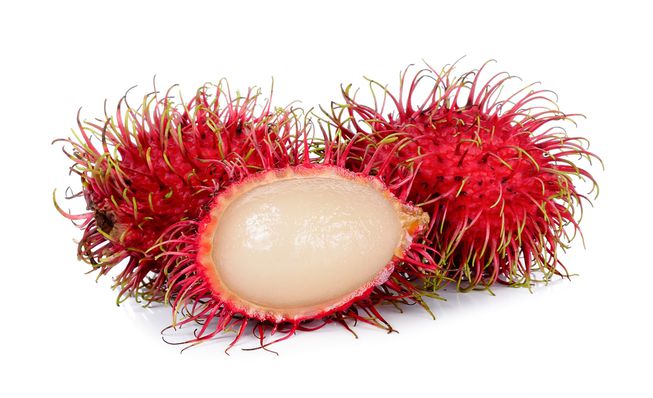

The rambutan is a medium-sized tropical tree in the family Sapindaceae. The name also refers to the edible fruit produced by this tree. The rambutan is native to the Indonesian region, and other regions of tropical Southeast Asia. It is closely related to several other edible tropical fruits including the lychee, longan, and mamoncillo.
Native to Indonesia, rambutan is commonly grown in various countries throughout the region. It has spread from there to parts of Asia, Africa, Oceania, and Central America. The widest variety of cultivars, wild and cultivated, are found in Indonesia and Malaysia.
Around the 13th to 15th centuries, Arab traders, who played a major role in Indian Ocean trade, introduced rambutan into Zanzibar and Pemba of East Africa. There are limited rambutan plantings in some parts of India. In the 19th century, the Dutch introduced rambutan from their colony in Southeast Asia to Suriname in South America. Subsequently, the plant spread to tropical Americas, planted in the coastal lowlands of Colombia, Ecuador, Honduras, Costa Rica, Trinidad, and Cuba. In 1912, rambutan was introduced to the Philippines from Indonesia. Further introductions were made in 1920 (from Indonesia) and 1930 (from Malaya), but until the 1950s its distribution was limited.
There was an attempt to introduce rambutan to the southeastern United States, with seeds imported from Java in 1906, but the species proved to be unsuccessful, except in Puerto Rico.
It is an evergreen tree growing to a height of 12–20 m. The leaves are alternate, 10–30 cm long, pinnate, with three to 11 leaflets, each leaflet 5–15 cm wide and 3–10 cm broad, with an entire margin. The flowers are small, 2.5–5 mm, apetalous, discoidal, and borne in erect terminal panicles 15–30 cm wide.
Rambutan trees can be male (producing only staminate flowers and, hence, produce no fruit), female (producing flowers that are only functionally female), or hermaphroditic (producing flowers that are female with a small percentage of male flowers).
The fruit is a round to oval single-seeded berry, 3–6 cm (rarely to 8 cm) long and 3–4 cm broad, borne in a loose pendant cluster of 10–20 together. The leathery skin is reddish (rarely orange or yellow), and covered with fleshy pliable spines, hence the name, which means 'hairs'. The fruit flesh, which is actually the aril, is translucent, whitish or very pale pink, with a sweet, mildly acidic flavor very reminiscent of grapes.
The single seed is glossy brown, 1–1.3 cm, with a white basal scar. Soft and containing equal portions of saturated and unsaturated fats, the seeds may be cooked and eaten. The peeled fruits can be eaten raw, or cooked and eaten: first, the grape-like fleshy aril, then the nutty seed, with no waste.